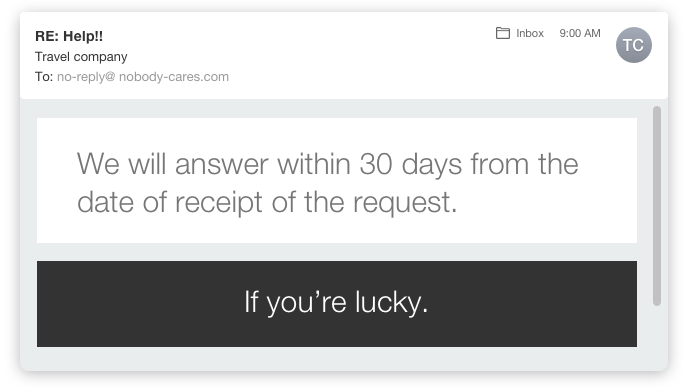When time is of the essence, fast email support is a given. But there’s much more to providing exceptional customer service when everything is ASAP.
The one constant in travel is that it’s always changing, and fast: flights are cancelled, trains delayed, luggage lost. When you’re on the train from Bruges to Belarus, you want to believe that the company you booked with has got your back.
Loco2’s customers are on mobile and on the move, so it’s critical that our support team acts fast to keep them on track.
9 lessons we’ve learned about providing fast customer service
We’ve seen it all — from landslides to lost passports, stolen wallets to missed trains — and we learned some hard lessons along the way. Here’s what we’ve learned about helping customers in the travel industry, where every minute matters.
1. Self-service is key
Self-service customer support is the new competitive differentiator. Not only do customers value products that let them help themselves, they increasingly .
When we launched our first DIY support feature — a basic refund tool — we hoped it would save us from the most time-critical requests. What we didn’t expect was the uptake.
Within a month, 65% of our refund requests were in-app and automatic. This simple tool punched a hole in incoming mail overnight, freeing up the team to get their teeth into other conversations.

On-demand resources for customers give them agency. And a solid, educational knowledge base means they can find answers immediately, without sending an email. Delivering a world-class customer experience on time and at scale means finding ways to help customers solve problems on their own, quickly and conveniently.
2. Be there when you’re needed
Sure, some drunk people accidentally book a train to the wrong city at midnight on a Monday. But most of your customers are creatures of habit.
Learning what your customers need and when they need it lets you schedule human support when it makes the biggest difference. Most European trains run during the day, so there’s no use building a 24/7 remote support team that’s online when our customers are sleeping.

If you make it easy, most users are happy to help themselves during off hours. But for seven days a week, up to 16 hours a day, we have real people online to help customers when nothing but personal service will do. Most are astonished to get any reply outside of 9-5, and customers in Europe are blown away when they hear from a real, thoughtful human at 11 p.m. (“You’re up late?!”), when one of our team members in Alaska is just finishing lunch.
3. Hold the phone
There’s nothing like a phone call to build rapport with customers. But unless you want to build a call center, it’s difficult for many companies to offer quality service over the phone at scale.
One person can spend hours on the phone, chatting about hypothetical problems or how to update their browser, while customers with urgent queries wait patiently for an email reply.
We unpublished our phone number in 2014 and haven’t looked back. For us, email support is the most efficient way to diagnose and debug customer issues. It means we can help more people, more quickly.
But striking a balance between time and efficiency means being flexible, too. Live chat is now on our roadmap, and we’re prepared to find out if it can deliver the best of both worlds — the rapport of phone, with the efficiency of emails. Watch this space.
4. Auto-reply, then human reply
“We’ll endeavor to get back to you within 30 days,” said nobody who cares, ever. No-reply email addresses and rubbish auto-replies are the enemies of time-sensitive support. We won’t stand for it, and neither should you.

Our customers get an auto-reply to let them know they’ll hear from us within 24 hours. But most days it’s more like three hours.
Companies that fail to deliver the fast email support that people expect will find that their customers track them down on social media anyway and make a fuss. Use a bot to under-promise then get a human to over-deliver. Your customers will love you for it.
5. Don’t wait until you’re asked
Triage, tagging and saved replies are helpful, effective tools to work through a busy queue quickly. But teasing out time-sensitive requests is easier if you’ve stopped some conversations before they’ve even started.
Preemptive, personalized notifications are among the most powerful tools for automating support in a way that adds real value for your users. Out of stock: Email me when available. It’s simple enough.
For us, this “simple” feature is among the most complicated parts of our technology — detecting when tickets aren’t yet on sale, and inviting customers to set an alert for a journey months or even years ahead.
The day tickets come on sale, we automatically notify travelers, sending them a link to the train, times and tickets they’ve probably forgotten they even need. They’re delighted, and we’ve intercepted literally thousands of new conversations about holidays in 2020.
6. Empathy is everything
When you’re in a hurry, it’s easy to forget that sometimes just being heard is enough. We can’t guarantee the experience of our customers when they’re traveling, but when they reach out to us, they know that the person at the other end of the email cares about what they’re going through.
Your support team can’t always deliver solutions, but they can always deliver empathy.
You can’t promise that every member of your team has lived every scenario, but building a culture of understanding means customers are treated with the respect they deserve.
Speedy support shouldn’t sacrifice compassion; it’s the foundation of every customer success story. If that means a terse reply when you’re up against the clock, no problem. But reaching out to them the next day — with an update, new idea, or helpful suggestion beyond the initial problem — shows that the team really cares about the outcome.
7. Expect the unexpected
Some things in life are inevitable: death, taxes, and bugs in your software. Don’t “apologize for the inconvenience.” Fix it. And fast.
You can’t fix every problem right away, but having a robust recovery plan for the most common, time-critical issues will get you back on your feet more quickly, and it will prevent customers from hitting the panic button.
Empowering your tech team — making them an extension of support — is an important part of that. For our most critical errors, we’ve built a suite of tools so developers can put things right themselves:
Error reporting that tracks individual user experience, sending critical alerts to the team
Unambiguous error messages and sound knowledge base articles to reassure the customer
A schedule of on-call developers so it’s clear who’s responsible during off hours
Internal docs that outline Plan A and Plan B, with saved replies ready to go
While it may sound like a lot, it’s a process that’s dialed in and designed to resolve a frustrating error as quickly as possible, as well as soothe any customer anxiety. Done right, it’s an opportunity to turn a potentially negative situation into a positive customer experience.
8. LOUD SHOUTYCAPS DO NOT CORRELATE TO URGENCY!!!!
Mister loud shoutycaps may think his message is the most important. But the most effective support teams are those that learn to separate outrage from urgency.
Sure, certain support requests require a greater sense of urgency — we use workflows to tag conversations when a customer sends three messages in quick succession (or helpfully puts “Urgent” in the subject). But we rely on triage, with clear processes, checks and balances, to keep things moving and make sure that more courteous customers don’t lose out to those who shout loudest.
The customer who makes the most noise can keep your support rep from helping those who truly need it quickly. So working up solid systems to read, tag and prioritize incoming messages is an art worth practicing to thoughtfully manage a fast and furious inbox.
9. Everything changes
Every day, something changes: new trains, tickets, features, bugs, weather, politics. This constant change means our support team needs to be flexible, responsive and in touch — not only with customers, but with one another, too.
Our #train-geeks channel in Slack is a place of fast-flowing information, problems and solutions (as well as weird and wonderful Slackmojis).
Group chat is good for many things, but conversations quickly become buried and are difficult to find and use as a reference later on. And with a remote, distributed support team, we rely on much more than chat to react to changing times.
Trello is the hub of communication for our product team — and a vital tool in reporting customer issues — but it’s also how our support team tracks changes in our knowledge base.
Basecamp is where we post “Staying on Track” notes: asynchronous updates about new features, processes and live issues that the entire team can read and delete, knowing the information is always easy to find again.
A combination of flexibility, experimentation, and sound principles of communication has allowed us to fine-tune our support in a fast-moving industry.
Customers want and deserve kind, speedy and practical responses, and with a little streamlining and paying close attention to patterns and history, that speed and empathy is possible without the phone or 24-hour support.







